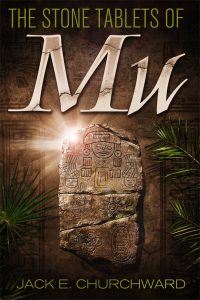Two years ago today, The Stone Tablets of Mu was officially released.

Pick up your copy today…
Two years ago today, The Stone Tablets of Mu was officially released.

Pick up your copy today…
Comments Off on The Stone Tablets of Mu
Posted in Miscellaneous, References to James' work
Mu – Fact or Fiction
Elizabeth G. Wilcox
Pageant Press, Inc. NY
1963

This book provides a one-sided approach to answering the question posed in the title. In the preface, the author makes it clear:
Many archaeologists ignore the facts. One reason for their not admitting the truth is that so few can decipher the tablets, especially those written in prehistoric times. Archaeology involves reading as well as uncovering them.
Essentially, we are told that archaeologists are too stupid to believe in the Lost Continent of Mu due to the inability to decipher unidentified prehistoric tablets. Such a ludicrous statement to dismiss the “Fiction” aspect from the discussion does not indicate a fair hearing of facts.
Author Wilcox uses the Naacal tablets as the first evidence of Mu. Followed by the Ramayana, the Troano Manuscript, the Codex Cortesianus and the Lhasa Record, she continues almost the same litany as James Churchward, although reduced in size.
There is content other than from James’ works with thirty pages of photos and drawings in the back. There are also many illustrations easily recognizable from James’ works.
Also contained in the preface is a plea for people to work together to achieve “good and happiness.” One has to wonder what that really means. In subsequent passages, the author continues the debunked and discredited theory that ancient Americans built the monumental structures and ruled until the “darker-skinned people drove the while people from the land.” I don’t want to speculate on the author’s motivations, how she expects “good and happiness” will be effected, or put words in her mouth. My thought is that until we, as humans, recognize our shared human experience, allow people the dignity of their history, and treat each human life as sacred then we will have a tough time achieving global “good and happiness.”
Comments Off on Review: Mu – Fact or Fiction
Posted in Lost continent of Mu, Miscellaneous, References to James' work
I allowed a month for the answer to be emailed and received no responses.
The first question was answered and posted in a Facebook group and in a comment to the blog posting- it is the Lyakhovsky Islands, also spelled:
The second question, where could James have read about an island made up of the bones and tusks of mammoths and other forest creatures? Or that ice was not involved in the flooding since it would have mashed up all the bones.
The novels by Jules Verne say the islands are made of whale and mammoth bones, but nothing about a flood.
Several of the books listed above quote from the account of Sannikow (Sannikov), a companion of the explorer Hedenstrom,
In quantity, however, these bones increase wonderfully to the northward, and, as Sannikow expresses himself, the whole soil of the first of the Lachow Islands appears to consist of them.
Narrative of an Expedition to Siberia and the Polar Seas
and
In the words of Sannikow, one of Hedenström’s companions, “the first of the Laechow Islands is little more than one mass of mammoth’s bones,” and though for upwards of eighty years the Siberian traders have been bringing over annually large cargoes of them, there appears as yet to be no sensible diminution in the apparently inexhaustible store.
The Museum of Foreign Literature, Science And Art Vol X
In The Living Age Vol. 204 (1895), a story (Treasure Islands in the Polar Sea) discusses the presence of the bones as follows:
We cannot fully answer these questions. It seems probable, however, that great floods of rushing water must poured over these lands, and great invasions of the waters of the ocean must have inundated them. In these tremendous deluges the elephants, rhinoceroses, and buffaloes were destroyed and their carcasses were piled up in heaps in the places where they had congregated to take refuge from the rising waters. When these deluges subsided and the waters retired, the lands were covered with remains of the drowned animals, in some as yet unexplained manner the climate changed and northern Siberia which was formerly a beautiful and verdant region became an icy wilderness and a land of death.
In The Mammoth and the Flood (1887), Howorth states as follows:
So it is clear that at the time when the elephants and trunks of trees were heaped tip together, one flood extended from the centre of the continent to the furthest barrier existing in the sea as it now is. That flood may have poured down from the high mountains through the rocky valleys. The animals and trees which it carried off from above could sink but slowly in the muddy and rapid waves, but must have been thrown upon the older parts of Kotelnoi and New Siberia in the greatest number and with the greatest force, because these islands opposed the last bar to the diffusion of the waters.”
Is there a smoking gun to provide the precise wording? Maybe, but I didn’t find one complete passage to match what James wrote.
It is clear that Howorth in The Mammoth and the Flood wrote about a north-bound flood and also quotes Sannikow about the composition of the islands being comprised of mammoth and other animal bones.
Maybe The Mammoth and the Flood is the smoking gun being sought and the answer to the second question.
Of course, if anyone is interested and comes up with a better answer, I am all ears.
Have a great day.